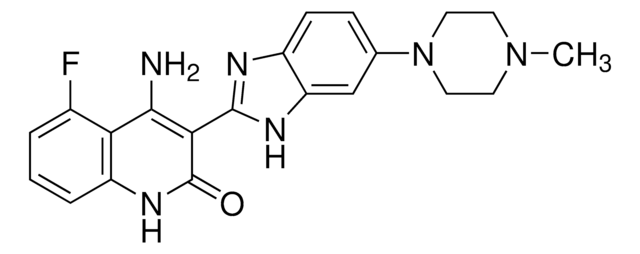SRP3115
MIP-1 beta (CCL4) human
recombinant, expressed in E. coli, ≥98% (SDS-PAGE), ≥98% (HPLC), suitable for cell culture
Synonim(y):
ACT-2, CCL4
Zaloguj sięWyświetlanie cen organizacyjnych i kontraktowych
About This Item
Kod UNSPSC:
12352202
NACRES:
NA.32
Polecane produkty
pochodzenie biologiczne
human
rekombinowane
expressed in E. coli
Próba
≥98% (HPLC)
≥98% (SDS-PAGE)
Postać
lyophilized
masa cząsteczkowa
7.6 kDa
opakowanie
pkg of 10 μg
metody
cell culture | mammalian: suitable
zanieczyszczenia
<0.1 EU/μg endotoxin, tested
kolor
white to off-white
numer dostępu UniProt
Warunki transportu
wet ice
temp. przechowywania
−20°C
informacje o genach
human ... CCL4(6351)
Opis ogólny
Both MIP-1α and MIP-1β (macrophage inflammatory proteins-1α and β) are structurally and functionally related CC chemokines. They are secreted by activated human monocytes and peripheral blood lymphocytes. The gene encoding this protein is localized on human chromosome 17q12. Both human and murine MIP-1α and MIP-1β are active on human and murine hematopoietic cells. Recombinant human MIP-1β is a 7.6kDa protein containing 69 amino acid residues, including the four highly conserved cysteine residues present in CC chemokines.
Działania biochem./fizjol.
MIP-1α and MIP-1β (macrophage inflammatory proteins-1α and β) participate in the host response to invading bacterial, viral, parasite and fungal pathogens by regulating the trafficking and activation state of selected subgroups of inflammatory cells e.g. macrophages, lymphocytes and natural killer (NK) cells. While both MIP-1α and MIP-1β exert similar effects on monocytes their effect on lymphocytes differ; with MIP-1α selectively attracting CD8+ lymphocytes and MIP-1β (also known as C-C motif chemokine ligand 4) selectively attracting CD4+ lymphocytes. Additionally, MIP-1α and MIP-1β have also been shown to be potent chemoattractants for B cells, eosinophils and dendritic cells.
Sekwencja
APMGSDPPTA CCFSYTARKL PHNFVVDYYE TSSLCSQPAV VFQTKRGKQV CADPSESWVQ EYVYDLELN
Postać fizyczna
Lyophilized with no additives.
Rekonstytucja
Centrifuge the vial prior to opening. Reconstitute in water to a concentration of 0.1-1.0 mg/ml. Do not vortex. This solution can be stored at 2-8°C for up to 1 week. For extended storage, it is recommended to further dilute in a buffer containing a carrier protein (example 0.1% BSA) and store in working aliquots at -20°C to -80°C.
Ta strona może zawierać tekst przetłumaczony maszynowo.
Kod klasy składowania
11 - Combustible Solids
Klasa zagrożenia wodnego (WGK)
WGK 3
Temperatura zapłonu (°F)
Not applicable
Temperatura zapłonu (°C)
Not applicable
Certyfikaty analizy (CoA)
Poszukaj Certyfikaty analizy (CoA), wpisując numer partii/serii produktów. Numery serii i partii można znaleźć na etykiecie produktu po słowach „seria” lub „partia”.
Masz już ten produkt?
Dokumenty związane z niedawno zakupionymi produktami zostały zamieszczone w Bibliotece dokumentów.
S D Wolpe et al.
The Journal of experimental medicine, 167(2), 570-581 (1988-02-01)
We report the identification and purification of a new inflammatory monokine synthesized by the macrophage tumor cell line RAW 264.7 in response to endotoxin. This monokine, which we term "macrophage inflammatory protein" (MIP), is a doublet with an apparent molecular
Biology of the RANTES/SIS cytokine family.
T J Schall
Cytokine, 3(3), 165-183 (1991-05-01)
CCL3L1 and CCL4L1 chemokine genes are located in a segmental duplication at chromosome 17q12.
Modi WS
Genomics, 83(4), 735-738 (2004)
K Hieshima et al.
Journal of immunology (Baltimore, Md. : 1950), 159(3), 1140-1149 (1997-08-01)
By searching the expressed sequence tag (EST) database, we identified partial cDNA sequences encoding a polypeptide with significant sequence identity to the human CC chemokine macrophage-inflammatory protein-1 alpha (MIP-1 alpha)/LD78 alpha. We determined the complete cDNA sequence that contained a
MicroRNA-125b modulates inflammatory chemokine CCL4 expression in immune cells and its reduction causes CCL4 increase with age.
Cheng NL
Aging Cell, 14(2), 200-208 (2015)
Nasz zespół naukowców ma doświadczenie we wszystkich obszarach badań, w tym w naukach przyrodniczych, materiałoznawstwie, syntezie chemicznej, chromatografii, analityce i wielu innych dziedzinach.
Skontaktuj się z zespołem ds. pomocy technicznej